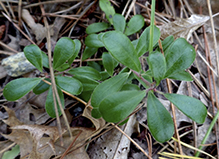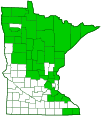bearberry
(Arctostaphylos uva-ursi)
Conservation • Wetland • Description • Habitat • Ecology • Use • Distribution • Taxonomy
Description |
||
Bearberry is a low growing, woody, evergreen shrub. It is native to Europe, Asia, and North America. In Minnesota it is fairly common in the north, uncommon in the central, metro, and southeast regions, and absent from the southwest region. It is found in open areas of forests, sand dunes, old fields, and urban areas. It grows in dry sites under full sun on acidic rocky soil and on sand. Bearberry is a perennial shrub that rises from woody roots. The stem is branched, is up to 40″ (1 m) long, and lies flat on the ground with only the tip ascending (decumbent). The branches are erect or curve up from the base (ascending). Where the stem and branches touch the ground it forms roots and often creates a new plant (layering). This is the plant’s primary means of reproduction. It often forms mats up to 40″ (1 m) wide that are clones of a single plant. Young stems and branches are erect and 2″ to 8″ (5 to 20 cm) tall. They are whitish-green to red or brown, round in cross section, and hairy. The hairs may be long, short, glandular, non-glandular, or a combination of these. Older stems are woody and covered with brown bark that eventually peels or flakes. After two or three years the branches become decumbent and may root and produce a new plant where they touch the ground. The leaves are alternate and evergreen, lasting up to two years. They are on 1⁄16″ to ⅛″ (2 to 4 mm) long leaf stalks. The leaf blades are thick, leathery, inversely lance-shaped or inversely egg-shaped (widest toward the tip), ⅜″ to 1″ (10 to 25 mm) long, and 3⁄16″ to ⅝″ (5 to1 5 mm) wide. They are wedge shaped at the base and rounded at the tip. They do not partly surround (clasp) the stem at the base. The upper surface is dark green, shiny, and hairless. The lower surface is medium green, dull, and usually hairless, sometimes sparsely hairy. The margins are untoothed. The leaves turn bright red in the fall. The inflorescence is a short, congested, usually unbranched cluster (raceme) of 2 to 15 flowers at the end of the previous year’s twigs. Sometimes the cluster has one branch. Each flower droops downward on a hairless, 1⁄16″ to ⅛″ (2 to 4 mm) long stalk (pedicel). The flowers are urn shaped and about ¼″ long. There are 5 outer floral leaves (sepals), 5 petals, 10 stamens, and 1 style. The sepals are light green to red, egg-shaped, and 1⁄32″ to 1⁄16″ (1 to 1.5 mm) long. The petals are mostly white, pinkish toward the tip. They are fused into an ⅛″ to ¼″ (4.5 to 6.5 mm) long, urn-shaped tube, then separated at the tip into 5 rounded, less than 1⁄32″ (1.0 mm) long lobes. The stamens and the style do not project beyond the tube. The fruit is a red, hairless, globe-shaped, ¼″ to ½″ (6 to 12 mm) in diameter drupe with 5 nutlets. It is edible but dry, mealy, and tasteless. |
||
Height |
||
2″ to 8″ |
||
Flower Color |
||
White |
||
Similar Species |
||
Habitat |
||
Dry. Open areas of forests, sand dunes, old fields, and urban areas. Full or partial sun. Acidic rocky soil or sand. |
||
Ecology |
||
Flowering |
||
Early May to early June |
||
Pests and Diseases |
||
|
||
Use |
||
|
||
Distribution |
||||
|
Sources |
|||
| 2/18/2023 | ||||
Nativity |
||||
Native |
||||
Occurrence |
||||
Common |
||||
Taxonomy |
|||
| Kingdom | Plantae (Plants) | ||
| Subkingdom | Pteridobiotina | ||
| Phylum | Tracheophyta (Vascular Plants) | ||
| Class | Magnoliopsida (Dicots) | ||
Order |
Ericales (heathers, balsams, primroses, and allies) | ||
Family |
Ericaceae (heath) | ||
| Subfamily | Arbutoideae (madrones, bearberries, and allies) | ||
Genus |
Arctostaphylos (bearberries and manzanitas) | ||
Subordinate Taxa |
|||
Many subspecies and varieties of bearberry have been described based on the on the length of hairs and the presence or absence of glandular hairs on young twigs. Recent analysis shows these differences to be environmentally produced. No subspecies or varieties are currently recognized. |
|||
Synonyms |
|||
Arctostaphylos adenotricha Arctostaphylos uva-ursi ssp. adenotricha Arctostaphylos uva-ursi ssp. coactilis Arctostaphylos uva-ursi ssp. longipilosa Arctostaphylos uva-ursi ssp. monoensis Arctostaphylos uva-ursi ssp. stipitata Arctostaphylos uva-ursi var. adenotricha Arctostaphylos uva-ursi var. coactilis Arctostaphylos uva-ursi var. leobreweri Arctostaphylos uva-ursi var. marinensis Arctostaphylos uva-ursi var. monoensis Arctostaphylos uva-ursi var. pacifica Arctostaphylos uva-ursi var. stipitata Arctostaphylos uva-ursi var. suborbiculata Uva-Ursi uva-ursi |
|||
Common Names |
|||
bear-grape bearberry bearberry manzanita hog-cranberry kinnikinnick mealberry mountain-box sandberry upland-cranberry uva-ursi |
|||
Glossary
Ascending
Growing upward at an angle or curving upward from the base.
Decumbent
Reclining on the ground but with the tip ascending.
Drupe
A fleshy fruit with usually a single hard, stone-like core, like a cherry or peach; a stone fruit.
Layering
A method of propagation where a stem or branch comes into permanent contact with the soil, sprouts roots, and then detaches from the main plant.
Pedicel
On plants: the stalk of a single flower in a cluster of flowers. On insects: the second segment of the antennae. On Hymenoptera and Araneae: the narrow stalk connecting the thorax to the abdomen: the preferred term is petiole.
Raceme
An unbranched, elongated inflorescence with stalked flowers. The flowers mature from the bottom up.
Visitor Photos |
|||||
Share your photo of this plant. |
|||||
| This button not working for you? Simply email us at info@MinnesotaSeasons.com. Attach one or more photos and, if you like, a caption. |
|||||
Luciearl |
|||||
 |
|||||
MinnesotaSeasons.com Photos |
|||||
|
|||||

Slideshows |
||

Visitor Videos |
|||
Share your video of this plant. |
|||
| This button not working for you? Simply email us at info@MinnesotaSeasons.com. Attach a video, a YouTube link, or a cloud storage link. |
|||
Other Videos |
|||
| kinnikinnick - Arctostaphylos uva-ursi. Identification and characteristics. Coastal Plants of BC - UBC Forestry |
|||
About
May 29, 2018 Coastal Indicator Plants of British Columbia. kinnikinnick - Arctostaphylos uva-ursi. University of British Columbia - Faculty of Forestry. Illustration Credit: Hitchcock, C. Leo, and Arthur Cronquist. Flora of the Pacific Northwest: An Illustrated Manual © 1973. Reprinted with permission of the University of Washington Press. |
|||
| Arctostaphylos uva-ursi, Ericaceae (kinnikinnick, bearberry) MHCC Dendrology |
|||
About
Sep 24, 2020 Welcome to Into the Forest: Tree and Shrub Identification with Pualani Derman, Instructor of Natural Resources Technology at Mt. Hood Community College. This video introduces you to Arctostaphylos uva-ursi (kinnikinnick, bearberry). This video is provided as part of a series for F141 Tree and Shrub Identification. This field-based course focuses on the identification, classification and distribution of key trees and shrubs of the Pacific Northwest as well as major tree species and forest types of North America. The course emphasizes botanical nomenclature and field identification using plant keys. This class introduces ranges, habitats, uses and silvical characteristics of key plant species. Find out more about the MHCC Natural Resources Technology program at https://www.mhcc.edu/NRT |
|||

Created: 10/20/2020
Last Updated:


